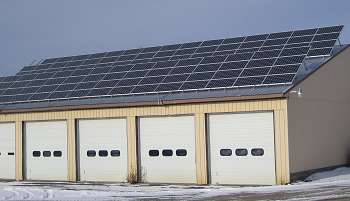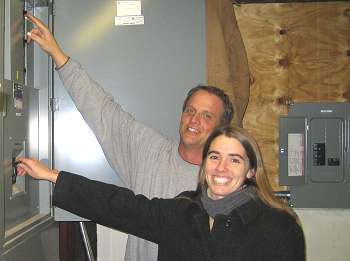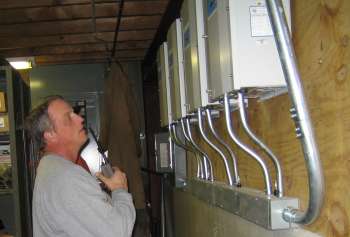- By Dan Veaner
- Around Town
 Print
Print 
Darby Kiley, who works half time for the Town and the other half for the Cayuga Lake Watershed Intermunicipal Organization, wrote and managed the $129,000 grant for the town. Highway Superintendent Jack French's team did most of the construction. "Finger Lakes Renewable Energy was here once in a while just to make sure it was being done right," Mr. French reports, "but our guys did 90% of the work." Highway department employees Chuck Starner, Mark Mosely and Scott Weaver did most of the work on the project.

Jack French and Darby Kiley switching on
The system is capable of producing 21.6 megawatts per year. The panels are positioned on the roof of the East wing of the building. They face South to get the most sunlight for the longest period each day. "It's pretty much a perfect roof for this," says Mr. French.
The Town worked with Finger Lakes Renewable Energy Cooperative to install the system. Ms. Kiley learned of the company while attending a workshop in Dryden. She worked with them and Mr. Shattuck as she wrote the grant that was officially accepted in October of last year. Construction began in June of this year, and the system was completed last August.
Paperwork required by NYSEG held up converting to the new system until this week. "Ms. Kiley says, "We had an inspection done, sent that to them, there was another review that had to be done before they'd send their person here today. It had to go through a technical review, and then Mark, who is coming out today, has to make sure it does turn on right." Since NYSEG is no longer a local company the paperwork had farther to travel, which contributed to the delay.
"I think it will be a learning experience for all of us, to see exactly how much it's going to save." The system only produces electricity in daylight, sending whatever power is not used into NYSEG's grid. "In this unit they're going to be using all of the power that they produce, says Finger Lakes Renewable Energy Cooperative's Rebekah Carpenter. The total production is not going to be greater than the total use for the building. Any excess power they do make will be pushed back into the main grid system. In a commercial system it just goes back and NYSEG gets it for free. In a residential system that is credited to the homeowner."
Last year the Highway Department building used $10,414.77 of electricity. While the system won't account for all electrical use, the Town estimates it will recover the costs in 10-15 years. If you consider the Highway Department employees would have been paid anyway and take their salaries out of the equation, that figure is reduced considerably.

Four inverters convert the DC current from the solar panels to usable AC electricity
Mr. French doesn't anticipate much maintenance, and doesn't think it will be necessary to brush snow off the panels. "What I'm really hoping is that those panels will give off enough heat that the snow will melt off a little bit." The system automatically deals with emergencies such as blackouts, shutting itself down so it won't cause problems with the main power grid. A unit in his office will eventually be able to display real time statistics from the system on the Town of Lansing Web site.
"The sparks are going to be at the NYSEG office when they realize how little money the Town of Lansing will be paying for electricity," said Ms. Carpenter. That will mean a savings of thousands of dollars every year.
----
v1i22



